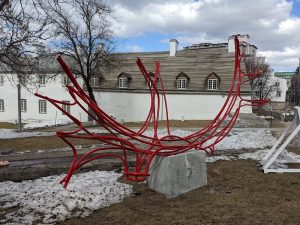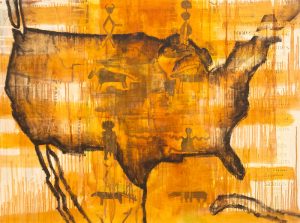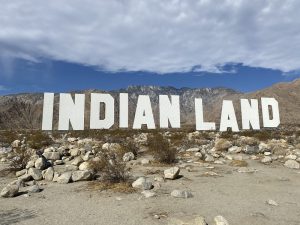Native American art as a tool against environmental injustice
Bruno Fregoso Frias
Preface:
My name is Bruno Fregoso Frias, this portfolio will be focused on contemporary Native American sculptures and paintings that express environmental concerns and injustices that continue to affect Native Americans today. This will be published using license CC BY-NC-SA.
Introduction:
Native American communities have long been victims of environmental injustices dating back to the colonization of the Americas. These injustices have led to what could be seen as the birthplace of modern environmental art, the American Indian Movement. The American Indian Movement was founded in 1968 and protested the systemic issues of cultural land preservation and any situation caused by environmental degradation, that led to illness and poverty. This movement has inspired modern-day artists alike who protest new threats to Native Communities. For this portfolio, the three artists I will be focusing on are Juane Quick-to-See Smith, Nicholas Galanin, and Cannupa Hanska Luger
Themes:
There are a plethora of themes covered in Native American art, but the two I will focus on are environmental degradation and its effects on communities as well as land preservation for green spaces in communities. Uranium mining near Navajo communities has led to uranium poisoning of nearby resources such as water. This has led to other consequences such as increased cancer and mortality rates. A lot of Native artists address this in their work, such as Juane Quick-to-See Smith, using color and old newspaper cutouts to put an emphasis on the struggles native communities face. New housing projects also threaten native land which acts as green spaces with huge cultural significance towards native communities. Jaune Quick-to-See Smith released a series of paintings from 1985-1987 that protested the Alberqeue housing project on native land. The project threatened the petroglyph park, an important green space for local native communities that have lost contact with their ancestral lands. Other artists, who advocate for Land preservation such as Nicholas Galanin and Cannupa Hanska Luger, both typically incorporate sculpture and public art, to create more public awareness of land conservation. Nicholas Galanin protested housing projects in the Aguas Caliente community and is largely involved with advocacy for proper land delegation. Cannupa Hanska Luger protested environmental degradation in the Standing Rock community, most recently with the Dakota Access Pipeline.
Some examples of Juane Quick-to-See Smith’s artwork on display at the Whitney Museum of American Art, via the youtube channel: Art Trip
Analysis:
This portfolio will be showcasing and analyze three different images, each from a different artist, which incorporates the themes previously discussed in their work.

Cannupa Hanska Luger Obtained via CC BY 2.0
The image depicted above showcases the sculpture, “Before the Eye” by Cannupa Hanska Luger. To provide historical context, Cannupa Hanska Luger is part of the Standing Rock community, which has been dealing with the proposal and operation of the Dakota Access pipeline. The Dakota Access pipeline was built to carry oil across states, with the controversy being the locations it crosses and the environmental threat it poses to local native communities. The pipeline was built on the borders of the tribe’s reserve, on land taken from the tribe by Congress in 1958. The Standing Rock community worried that the carbon emissions and a potential oil spill can contaminate their environment and drinking water, nonetheless, the project was constructed legally under state law without the approval of local communities. However, in 2021, it was ruled that an in-depth report on environmental impact was never performed and must be obtained in order to keep the pipeline operational. Although, it was also ruled that until this report is available, it is up to the presidential administration to keep the pipeline running. On May 3rd, 2021, the Biden administration continued the operation of the pipeline, angering the Standing Rock community, who cannot file a claim until the Environmental Impact Report is released in 2023. Given that Luger’s sculpture was put up in 2022, in between the decision to keep the pipeline operational and the wait for the environmental impact report, it is highly likely Luger is not just protesting the building of the pipeline, but the ignorance of government officials. Upon inspection of the sculpture, one can see a Caribou shedding its old antlers for a pair of new ones after the winter. The Caribou is an important animal for the survival of the Standing Rock community, now endangered due to environmental degradation. I believe that this image is showcasing that if we do not learn from previous experiences about protecting our environment, other important aspects of our environment will join the Caribou. In this specific case, I believe Luger is suggesting the threat the pipeline poses to the nearby communities who rely on water from the area.

Jaune Quick-to-See Smith (Salish, born 1940) Obtained via CC BY-NC 2.0
The painting above, Browning of America, by Jaune Quick-to-See Smith is a great painting to showcase the art styles that Smith frequently uses as well as the themes she presents in her artwork. Smith began to protest current events in her work after the mid-1980s when a proposed housing project in Albuquerque, New Mexico threatened a local park filled with ancient petroglyphs. Smith quickly got involved with advocacy for the preservation of the park which would later become recognized as a national monument. Such events have inspired Smith to take a new route in her artwork and focus on the theme of environmental degradation. In her painting “Browning of America”, Smith paints petroglyphs of various animals that were once a vast part of the Americas. The layers of brown paint and dripping effect symbolize time passing by and our disconnect and disregard for our environment. One of Smith’s trademark techniques in her paintings is the utilization of magazine cutouts to tie into modern-day themes. In this particular painting, there is a cutout that reads “Invaders of the East” symbolizing the colonization of native communities and the ecological threats that natives face in this post-colonial world. The browning effect likely refers to all the natural resources going to waste or being thrown away. Hailing from New Mexico, Smith is familiar with the uranium mining that took place in New Mexico, Arizona, Colorado, and Utah. This mining led to the poisoning of waters that the Navajo tribes used and has led to increased health risks such as cancer and illness. Images of the poisoned water appear to be a similar color to the brown Smith uses in her painting.

Never Forget, 2021. Palm Springs Obtained via CC BY-NC 2.0
The sculpture above is from 2001 in Palm Springs, California, by Nicholas Galanin titled “Never Forget”. The sculpture is clearly a play on the Hollywood sign, but for what reason? Many people are unaware that the original Hollywood sign read “Hollywood Land” and promoted a “whites-only” housing development in the area. Galanin rewrites the words Hollywood Land into Indian Land, a nod to the American Indian Movement. In the American Indian Movement’s occupation of Alcatraz in 1969, the words “Indian Land” filled the island, protesting the federal government’s exploitation of native resources, themes Galanin finds prevalent today. Studio contracts from the film industry have restricted travel, leading Palm Springs to become a popular location for housing projects. However, the nearby land in this area belongs to the Agua Caliente tribe, so Galanin was inspired to make this sculpture as a reminder that the land is not for open use. These areas are often green spaces and natural reserves for natives, building housing projects without permission shouldn’t be taking place, especially after all of the events from previous protests. Thus, “Never Forget” serves as a reminder that we should learn from past mistakes and not repeat them, native Land should be preserved and respected.
Application:
Native American art is some of the most important expressions we see in environmental humanities. Throughout history, Native American perspectives have been largely ignored by the majority of Americans and have led to some dire consequences for Native communities. Post-colonial developments have cornered native communities into unhealthy environments where humans continue to pollute and many development projects such as housing, threaten cultural land that should be preserved. The American Indian Movement helped inspire Native American art with an ecological perspective. Work from artists such as Cannupa Hanska Luger, Jaune Quick-to-See Smith, and Nicholas Galanin is important in helping us understand how to be more mindful of any native land we touch. These artists help highlight past atrocities that are largely ignored, such as uranium poisoning. They also advocate for land preservation, rather than non-natives just building wherever they please. Learning from native perspectives is of the most upmost importance if we want to help preserve their environment as a community.
Media Attributions
- Before the Eye © Retis is licensed under a CC BY (Attribution) license
- Browning of America © Thomas Hawk is licensed under a CC BY-NC (Attribution NonCommercial) license
- Never Forget © Rob Corder is licensed under a CC BY-NC (Attribution NonCommercial) license

